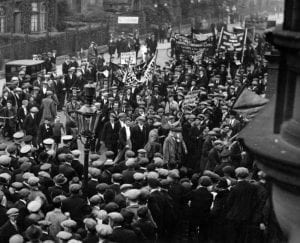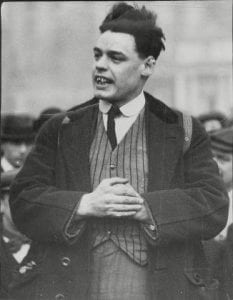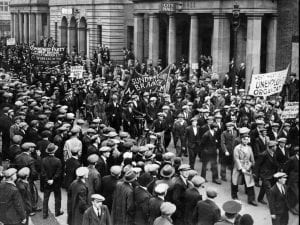Two years ago I wrote about an image John Coates’ friend, Tim Brown, was looking at. Tim was thinking that the policeman shown in the image was from the Middlesbrough Police Force; the force both had served in. After some enquiry we discovered that it was the Gateshead constabulary shown; we established that the Stockton contingent of the NUWM were marching across the Tyne Bridge. See – https://foxburg.edublogs.org/2020/08/14/the-stockton-branch/
I have since seen this image used fairly often, as it seems to be one of the few images in which the lettering on the banner can be seen in it’s entirety.
Two weeks ago I had cause to review this image once again. Peter Shearer shared an image showing – “Unemployed marchers moving through Northumberland Road, Newcastle in 1932.” which he had found on Mirrorpix.
Peter shared it to a Facebook page for Classic Photos of Newcastle and The East End and it was subsequently reposted on the North east Labour History Society Facebook page. When I saw it I contacted Peter, he told me where he’d found it and I downloaded a copy.

What first caught my eye was the Sunderland Branch banner, as this seemed to be the one seen in the Tyne Bridge photograph.
On blowing up the image to see the Sunderland Branch banner more clearly I realised that the Middlesbrough Communist Party banner can be seen and that this is also on the Tyne Bridge Photograph, although only ‘Communist Party’ can be made out. It is great that this new photograph allows us to see most of the lettering on the banner. We can also see that the West Hartlepool Unemployed Organisation banner in both photographs, they are taking part and marching with their own banner, this was a grouping I was unaware of up until now.
Clearly this is the same same group in the two pictures, meaning the pictures were taken at the same time but at different locations. They are very close in time as to reach Northumberland Road, the marchers would probably have moved north from the Tyne Bridge up Pilgrim Street, then continued up Northumberland Street, then turned right just before the Haymarket. This short distance confirms our suggestion from two years ago that the photograph of the Stockton contingent does show them on the Tyne Bridge.
I have found that there is also a second image in the Mirrorpix page which shows the same event and in this one the banners can be seen even more clearly, I think this second image shows the group further along from the previous photograph, showing them passing the City Hall. I’m really pleased that the Middlesbrough banner can be read quite easily.
I think these images show how well organised the march was. In a interview George Short tells us that the North East Group assembled in Newcastle on 4th October 1932 where a rally and speeches occured, and that a further Teesside contingent joined the North East Group at Darlington the next day, on the 5th October 1932.
As well as giving us a clear indication of the make up of the group it has also raised a few more intriging questions: for years I had pointed out that the smartly dressed man marching beside the NUWM men, I proposed that this was an MI5 officer detailed with following the march; we know some did as their reports are available in the National archives
The new photograph showing Northumberland Road has made me reconsider my proposal, for he seems in this picture to be stewarding the marchers, the men seem to accept him, he appears to be part of the contingent. He is dressed so much differently to the rest of the marchers that he stands out. 
The Tyne Bridge photograph suggested that the Stockton Contingent headed the Teesside groups; I think this it is now supported by these photographs, it seems that it is the back of the Stockton banner that can be seen going out of shot in the Northumberland Road photograph as the Stockton contingent are heading this group, and again they are missing from the second of these two new images as they have marched out of shot.
I am particularly pleased with the second picture, although it does not show the Stockton contingent it does shows so much more of the banners and the placards.
The placard which starts with ‘Sacrifice’ in much clearer and unobscured, unlike in the Tyne Bridge Photograph, and the West Hartlepool banner is very clear in this second picture.
In all eighteen contingents converged on London’s Hyde Park on 27th October 1932, where the 3,000 marchers were met by a crowd of between 50, 000 or 150, 000 depending upon which source you use. The Metropolitan police commissioner deployed 70, 000 police officers to control the crowd in 1932, the aim was to prevent the petition the men carried reaching Parliament; when the Police confiscated the Parliamentary petition in Hyde Park violence broke out. In scenes reminiscent of Peterloo mounted officers charged the huge crowd which contained women and children, resulting in 75 people being seriously injured. Phyllis Short recalls in interview that she was struck on the head by a mounted policeman and was therefore unable to attend the Mass Rally in Trafalgar Square the next day, but George did speak at Trafalgar Square.
The media blackout on publicity for Communist inspired protests ensured that very was reported, and this has meant that these events are overshadowed by the; in terms of numbers, tiny Jarrow Crusade. I think, however, that the photograph of Trafalgar square speaks for itself.
The NUWM leader Walter Hannington was arrested in Hyde Park, he was refused bail so he spent several months in jail. He tried to prosecute the Home Secretary Lord Trenchard the break in by police of the NUWM’s London offices; the Police broke in and destroyed the contents whilst Hannington was imprisoned. The Prime Minister, Ramsey MacDonald, personally intervened to prevent the prosecution of Lord Trenchard going ahead. This is why we don’t see many photographs of Wal’ Hannington in 1932.

I feel that these photographs give us a richer impression of the 1932 National Hunger March than we had and especially the organisation of the Teesside Communist Party. George Short had returned from the International Lenin School just a few months before the National Hunger March, but these images show the strength of the groups that were campaigning against The Means Test, and that they were well organised, a testimoney to the dedication and organisational ability of the small number of Communist Party activists.
These three images are a fantastic record of the 1932 National Hunger march and the North East contingent. I’m really pleased as I have some really exciting news regarding the Women’s Contingent on the 1932 March, I did write about it in 2020 – https://foxburg.edublogs.org/2020/08/17/more-on-the-stockton-branch/ but now I have some new material which is quite stunning.








